How to avoid falling for scams like "A File Was Shared With You Via Dropbox"
Phishing/ScamAlso Known As: A File Was Shared With You Via Dropbox phishing campaign
Get free scan and check if your device is infected.
Remove it nowTo use full-featured product, you have to purchase a license for Combo Cleaner. Seven days free trial available. Combo Cleaner is owned and operated by RCS LT, the parent company of PCRisk.com.
What is "A File Was Shared With You Via Dropbox"?
Upon reviewing this email, our team has determined that its intent is to deceive recipients into divulging personal information. These types of emails are known as phishing emails, and the scammers responsible for this particular email seek to lure victims into submitting sensitive data on a fraudulent website.
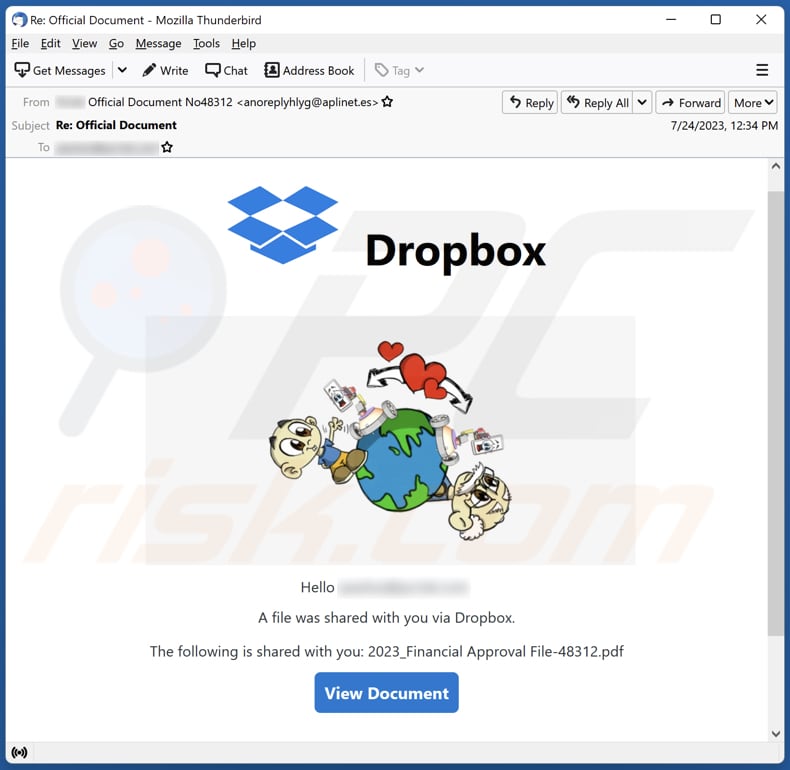
More about the "A File Was Shared With You Via Dropbox" scam email
This phishing email masquerades as a message from Dropbox, claiming that a file has been shared with the recipient. It includes a link to view the shared document, named "2023_Financial Approval File-48312.pdf" (its name may vary). The email tries to create a sense of urgency to entice the recipient to click on the provided link.
It mentions that the email was sent due to the recipient having a Dropbox account, attempting to make it seem authentic. However, the email is a fraudulent attempt to trick the recipient into clicking on the malicious link, which leads to a phishing website designed to steal login credentials (email addresses and passwords).
Scammers can use the stolen credentials to launch targeted phishing attacks. They can send deceptive emails to the victim's contacts and trick them into revealing more sensitive information or clicking on malicious links. By possessing the email address and password, scammers can also attempt to impersonate the victim and commit identity theft.
Also, scammers can gain unauthorized access to the victim's email accounts and other online services. They may exploit this access for financial gain by conducting fraudulent transactions or accessing sensitive personal information.
It is important to mention that scammers often use stolen email and password combinations to perform credential stuffing attacks on other websites and services. If victims reuse passwords across multiple platforms, scammers can gain unauthorized access to these accounts as well.
| Name | A File Was Shared With You Via Dropbox Email Scam |
| Threat Type | Phishing, Scam, Social Engineering, Fraud |
| Fake Claim | A file was shared with the recipient via Dropbox. |
| Disguise | Letter from Dropbox |
| Symptoms | Unauthorized online purchases, changed online account passwords, identity theft, illegal access of the computer. |
| Distribution methods | Deceptive emails, rogue online pop-up ads, search engine poisoning techniques, misspelled domains. |
| Damage | Loss of sensitive private information, monetary loss, identity theft. |
| Malware Removal (Windows) |
To eliminate possible malware infections, scan your computer with legitimate antivirus software. Our security researchers recommend using Combo Cleaner. Download Combo CleanerTo use full-featured product, you have to purchase a license for Combo Cleaner. 7 days free trial available. Combo Cleaner is owned and operated by RCS LT, the parent company of PCRisk.com. |
Similar scam emails in general
Phishing emails often form a sense of urgency or fear to prompt immediate action from the recipient. They may claim that an account is compromised, an invoice is overdue, or a time-sensitive offer is expiring, pressuring the recipient to act quickly without careful consideration.
Typically, such emails contain deceptive links or attachments that lead to fake websites designed to steal login credentials or other information. Also, emails can be used to distribute malware. Also, phishing emails often impersonate reputable organizations, companies, or other entities.
Examples of emails used to steal sensitive information are "Account Violation Detected", "Your Email Has Used Up It Inbox Space", and "Your Mailbox Will Be Temporarily Blocked".
How do spam campaigns infect computers?
Users can infect computers via email when they interact with harmful attachments or links embedded in phishing emails. Phishing emails often deceive recipients by appearing legitimate and may contain various types of files, such as documents (e.g., PDF, DOC), executable files (e.g., EXE), JavaScript files, or compressed archives (e.g., ZIP).
When users open or execute these files, malware hidden within them gets activated, infecting the computer and potentially causing harm, data loss, or unauthorized access to sensitive information.
How to avoid installation of malware?
To avoid malware, practice safe internet habits, such as not opening email attachments or website links received from unknown or suspicious addresses. Only download software from reputable and official websites. Keep your operating system and software up to date with the latest security patches.
Install a reliable antivirus or anti-malware program and perform regular system scans to remove potential threats. Additionally, be cautious when dealing with pop-ups or advertisements on dubious websites, as they may lead to malware installations. If you've already opened malicious attachments, we recommend running a scan with Combo Cleaner Antivirus for Windows to automatically eliminate infiltrated malware.
Text presented in the "A File Was Shared With You Via Dropbox" email letter:
Subject: Re: Official Document
Dropbox
Hello -A file was shared with you via Dropbox.
The following is shared with you: 2023_Financial Approval File-48312.pdf
View Document
This email arrived in your inbox because you have a Dropbox account. (Drobox). Any questions? Feel free to contact us or view our privacy policy and terms of use.
Screenshot of the phishing page:
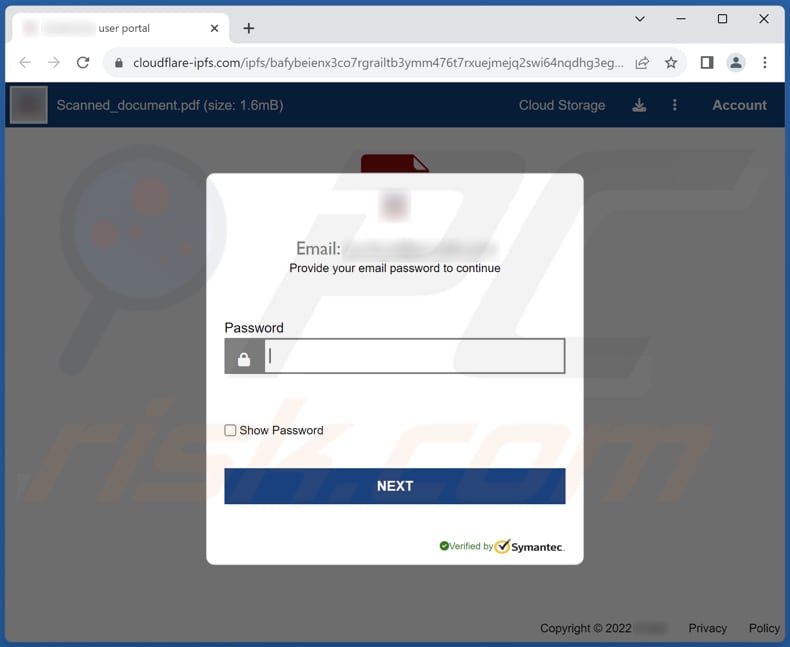
Another example of a spam email from "A File Was Shared With You Via Dropbox" spam campaign:
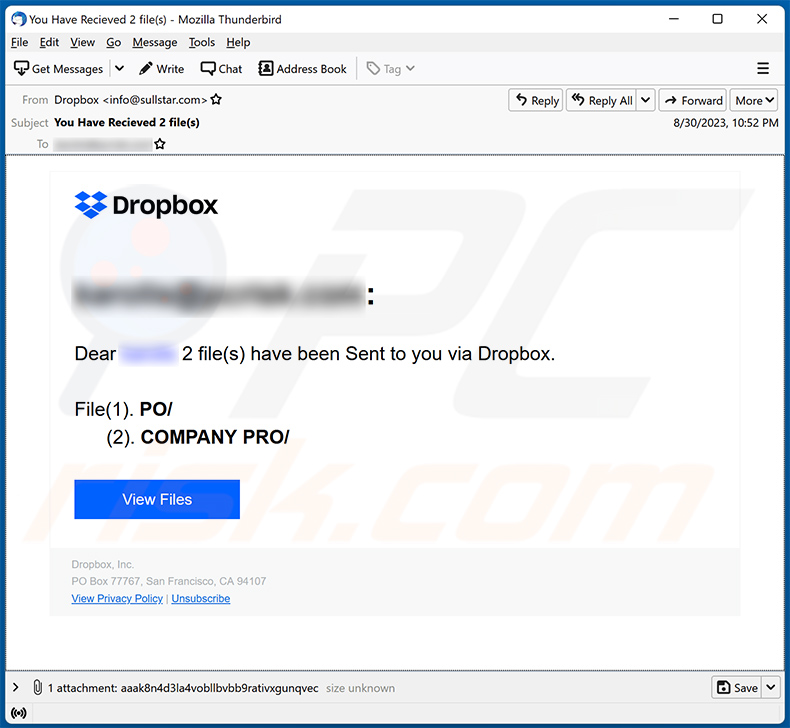
Text presented within:
Subject: You Have Recieved 2 file(s)
Dropbox
********:
Dear ******** 2 file(s) have been Sent to you via Dropbox.File(1). PO/
(2). COMPANY PRO/
View Files
Dropbox, Inc.
PO Box 77767, San Francisco, CA 94107
View Privacy Policy | Unsubscribe
Screenshot of the promoted phishing site:
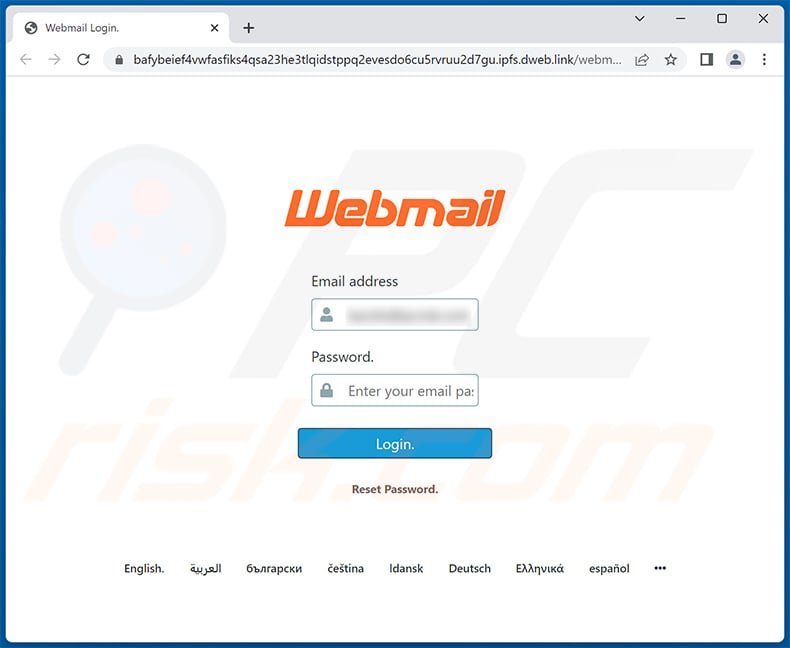
Yet another example of an email from "A File Was Shared With You Via Dropbox" spam campaign:
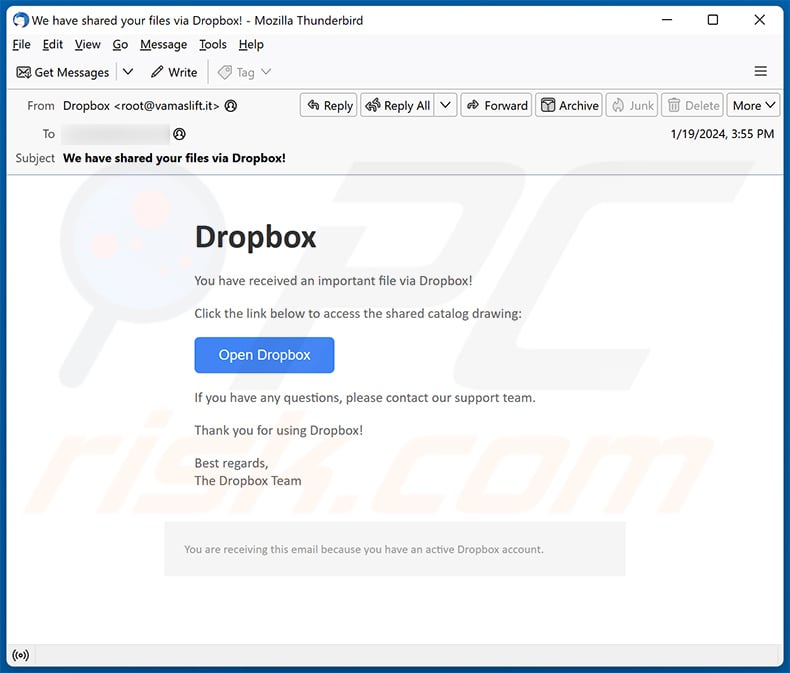
Text presented within:
Subject: We have shared your files via Dropbox!
DropboxYou have received an important file via Dropbox!
Click the link below to access the shared catalog drawing:
Open Dropbox
If you have any questions, please contact our support team.
Thank you for using Dropbox!
Best regards,
The Dropbox TeamYou are receiving this email because you have an active Dropbox account.
Screenshot of the phishing site promoted via this email:
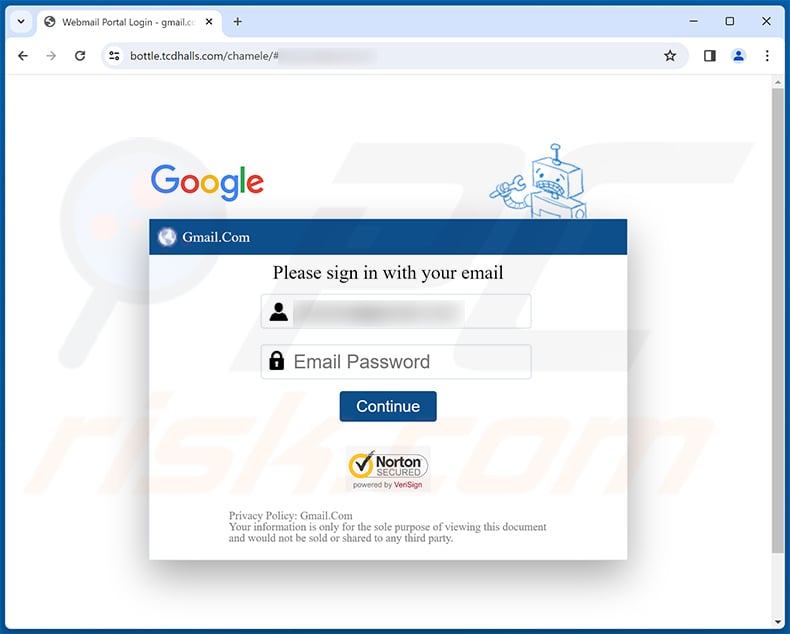
Yet another example of an email from "A File Was Shared With You Via Dropbox" spam campaign:
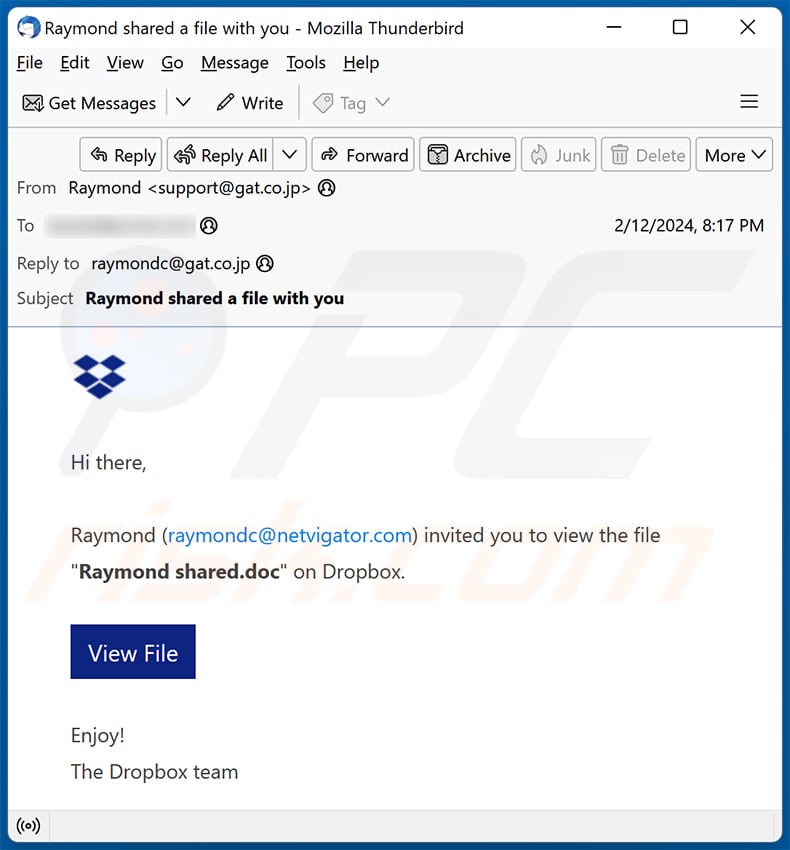
Text presented within:
Subject: Raymond shared a file with you
Hi there,Raymond (raymondc@netvigator.com) invited you to view the file "Raymond shared.doc" on Dropbox.
View File
Enjoy!
The Dropbox team© 2024 Dropbox
Screenshot of the promoted phishing site:
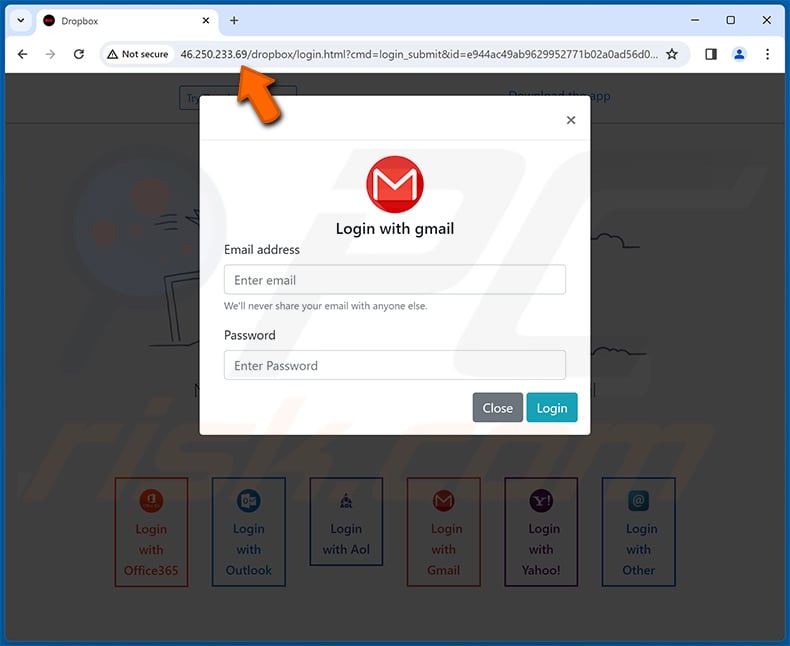
Instant automatic malware removal:
Manual threat removal might be a lengthy and complicated process that requires advanced IT skills. Combo Cleaner is a professional automatic malware removal tool that is recommended to get rid of malware. Download it by clicking the button below:
DOWNLOAD Combo CleanerBy downloading any software listed on this website you agree to our Privacy Policy and Terms of Use. To use full-featured product, you have to purchase a license for Combo Cleaner. 7 days free trial available. Combo Cleaner is owned and operated by RCS LT, the parent company of PCRisk.com.
Quick menu:
- What is A File Was Shared With You Via Dropbox phishing campaign?
- Types of malicious emails.
- How to spot a malicious email?
- What to do if you fell for an email scam?
Types of malicious emails:
![]() Phishing Emails
Phishing Emails
Most commonly, cybercriminals use deceptive emails to trick Internet users into giving away their sensitive private information, for example, login information for various online services, email accounts, or online banking information.
Such attacks are called phishing. In a phishing attack, cybercriminals usually send an email message with some popular service logo (for example, Microsoft, DHL, Amazon, Netflix), create urgency (wrong shipping address, expired password, etc.), and place a link which they hope their potential victims will click on.
After clicking the link presented in such email message, victims are redirected to a fake website that looks identical or extremely similar to the original one. Victims are then asked to enter their password, credit card details, or some other information that gets stolen by cybercriminals.
![]() Emails with Malicious Attachments
Emails with Malicious Attachments
Another popular attack vector is email spam with malicious attachments that infect users' computers with malware. Malicious attachments usually carry trojans that are capable of stealing passwords, banking information, and other sensitive information.
In such attacks, cybercriminals' main goal is to trick their potential victims into opening an infected email attachment. To achieve this goal, email messages usually talk about recently received invoices, faxes, or voice messages.
If a potential victim falls for the lure and opens the attachment, their computers get infected, and cybercriminals can collect a lot of sensitive information.
While it's a more complicated method to steal personal information (spam filters and antivirus programs usually detect such attempts), if successful, cybercriminals can get a much wider array of data and can collect information for a long period of time.
![]() Sextortion Emails
Sextortion Emails
This is a type of phishing. In this case, users receive an email claiming that a cybercriminal could access the webcam of the potential victim and has a video recording of one's masturbation.
To get rid of the video, victims are asked to pay a ransom (usually using Bitcoin or another cryptocurrency). Nevertheless, all of these claims are false - users who receive such emails should ignore and delete them.
How to spot a malicious email?
While cyber criminals try to make their lure emails look trustworthy, here are some things that you should look for when trying to spot a phishing email:
- Check the sender's ("from") email address: Hover your mouse over the "from" address and check if it's legitimate. For example, if you received an email from Microsoft, be sure to check if the email address is @microsoft.com and not something suspicious like @m1crosoft.com, @microsfot.com, @account-security-noreply.com, etc.
- Check for generic greetings: If the greeting in the email is "Dear user", "Dear @youremail.com", "Dear valued customer", this should raise suspiciousness. Most commonly, companies call you by your name. Lack of this information could signal a phishing attempt.
- Check the links in the email: Hover your mouse over the link presented in the email, if the link that appears seems suspicious, don't click it. For example, if you received an email from Microsoft and the link in the email shows that it will go to firebasestorage.googleapis.com/v0... you shouldn't trust it. It's best not to click any links in the emails but to visit the company website that sent you the email in the first place.
- Don't blindly trust email attachments: Most commonly, legitimate companies will ask you to log in to their website and to view any documents there; if you received an email with an attachment, it's a good idea to scan it with an antivirus application. Infected email attachments are a common attack vector used by cybercriminals.
To minimise the risk of opening phishing and malicious emails we recommend using Combo Cleaner Antivirus for Windows.
Example of a spam email:
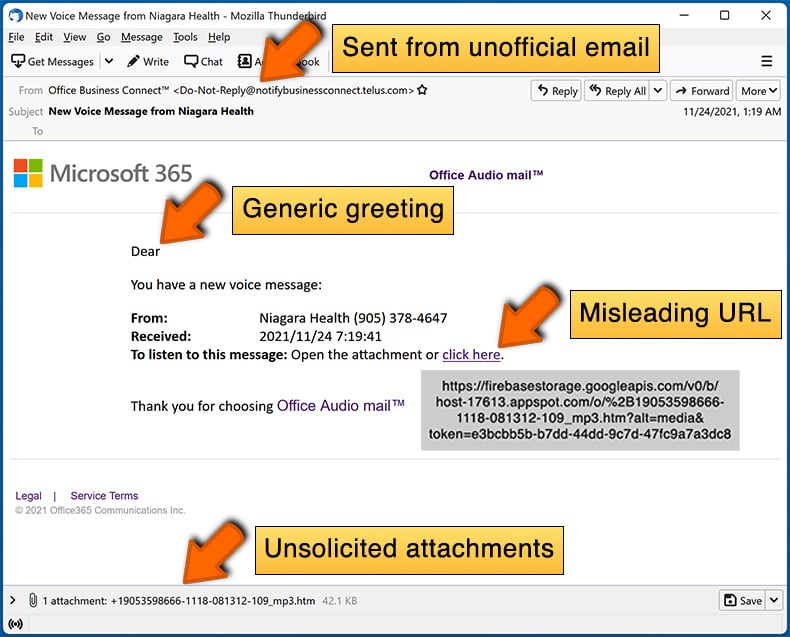
What to do if you fell for an email scam?
- If you clicked on a link in a phishing email and entered your password - be sure to change your password as soon as possible. Usually, cybercriminals collect stolen credentials and then sell them to other groups that use them for malicious purposes. If you change your password in a timely manner, there's a chance that criminals won't have enough time to do any damage.
- If you entered your credit card information - contact your bank as soon as possible and explain the situation. There's a good chance that you will need to cancel your compromised credit card and get a new one.
- If you see any signs of identity theft - you should immediately contact the Federal Trade Commission. This institution will collect information about your situation and create a personal recovery plan.
- If you opened a malicious attachment - your computer is probably infected, you should scan it with a reputable antivirus application. For this purpose, we recommend using Combo Cleaner Antivirus for Windows.
- Help other Internet users - report phishing emails to Anti-Phishing Working Group, FBI’s Internet Crime Complaint Center, National Fraud Information Center and U.S. Department of Justice.
Frequently Asked Questions (FAQ)
Why did I receive this email?
Scammers send identical emails to a large number of recipients, hoping to deceive at least one person. These spam messages are never personalized.
I have provided my personal information when tricked by this email, what should I do?
If you have unknowingly provided your email address and password to scammers, go to the official website of the affected account and change your password immediately. If other accounts can be accessed with the same or similar login credentials, change their passwords too. If you cannot access your account, try contacting the service provider.
I have downloaded and opened a malicious file attached to an email, is my computer infected?
Downloading and opening a malicious file attached to an email can put your computer at risk of malware infection. The potential for infection depends on the type of file you opened. Certain file types, such as executables, scripts, or macro-enabled documents, are more likely to contain malware and pose a higher risk than non-executable file formats like PDFs or images.
I have read the email but didn't open the attachment, is my computer infected?
Opening an email by itself is safe and does not pose a threat to your system. However, caution should be exercised when clicking links within the email or opening attached files, as these actions can potentially lead to system infections.
Will Combo Cleaner remove malware infections that were present in email attachment?
Combo Cleaner can detect and remove nearly all known malware infections. Sophisticated malware can conceal itself deeply within the system, making running a full system scan necessary to detect and eliminate the malware.
Share:

Tomas Meskauskas
Expert security researcher, professional malware analyst
I am passionate about computer security and technology. I have an experience of over 10 years working in various companies related to computer technical issue solving and Internet security. I have been working as an author and editor for pcrisk.com since 2010. Follow me on Twitter and LinkedIn to stay informed about the latest online security threats.
PCrisk security portal is brought by a company RCS LT.
Joined forces of security researchers help educate computer users about the latest online security threats. More information about the company RCS LT.
Our malware removal guides are free. However, if you want to support us you can send us a donation.
DonatePCrisk security portal is brought by a company RCS LT.
Joined forces of security researchers help educate computer users about the latest online security threats. More information about the company RCS LT.
Our malware removal guides are free. However, if you want to support us you can send us a donation.
Donate
▼ Show Discussion